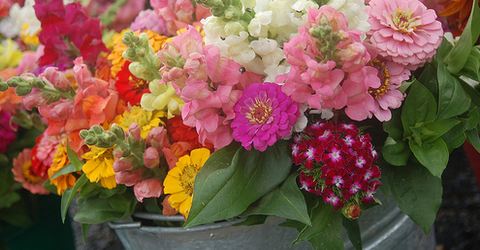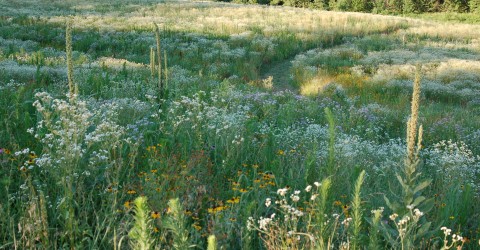Generating Revenue from Biodiversity
By: Amos S. Eno
Posted on:07/13/2012 Updated:08/02/2012A farmer grapples with how to make conservation pay for itself
This is a continuation of an earlier blog post about The Farm at Sunnyside's first annual Conservation Work Summary.
As part of its conservation efforts, The Farm at Sunnyside is exploring opportunities to “generate revenue and educate the public on the value of biodiversity.” One step in this regard is the harvesting and selling of fruits, berries, flowers and other products from wild species found on the Farm.
 “We’ve been selling wildflowers and paw paws, a surprise hit, at farmers’ markets in DC to help recoup the costs of restoration,” explains Nick Lapham, owner of The Farm at Sunnyside. “We started doing this in 2011 at a very small scale and based on the response are now exploring how we might scale up these efforts such that they could meaningfully contribute to our overall economic sustainability.”
“We’ve been selling wildflowers and paw paws, a surprise hit, at farmers’ markets in DC to help recoup the costs of restoration,” explains Nick Lapham, owner of The Farm at Sunnyside. “We started doing this in 2011 at a very small scale and based on the response are now exploring how we might scale up these efforts such that they could meaningfully contribute to our overall economic sustainability.”
Recovering Conservation Costs
I was curious about whether the Farm has benefited from any of the NRCS Farm Bill programs. Nick explained that they have limited acreage under the Conservation Reserve Enhancement Program (CREP) but have not yet actively pursued other potential funding sources. Still, Nick believes that such programs are fundamental to the widespread adoption of conservation practices on private lands and laments that “these programs remain poorly understood by a lot of folks,” a refrain that will not come as a surprise to many of my readers. “The array of programs is quite remarkable, at both the Federal and state level,” says Nick. “For example, Virginia has recently launched a new initiative aimed at rebuilding quail populations that provides generous incentives for landowners who establish native warm season grass and other quail-friendly habitat.”
Ideas that Work
Down the line, Nick hopes to explore emerging markets for ecosystem servic  es as another potential revenue stream. For example, he spoke about the potential to generate credits for habitat improvement (e.g., targeted to species of critical conservation concern) that could be developed and sold as an “offset” in an environmental market, such as the Bay Bank.
es as another potential revenue stream. For example, he spoke about the potential to generate credits for habitat improvement (e.g., targeted to species of critical conservation concern) that could be developed and sold as an “offset” in an environmental market, such as the Bay Bank.
A willingness to experiment and try new methods has taught Nick and the staff at Sunnyside quite a lot. Nick’s modus operandi is to be innovative and transparent. “Putting stuff out there is ess ential to our learning. We want the feedback,” he says. “We also hope that by sharing our experiences we may be able to inspire other landowners to adopt similar practices.” He explains, “They don’t n eed to bite off the whole program. Part of the idea behind our conservation report is to provide a forum that allows people to identify bits and pieces most suitable and appropriate to their own circumstances.”
Effective new ideas may be The Farm’s best crop of all.
Feedback
re: Generating Revenue from BiodiversityBy: Richard Day on: 07/19/2012I'm interested in Nick's lamenting that "these programs remain poorly understood by a lot of folks". Is this something you, Nick, could expand on? I have reason to believe that the field agents are challenged in understanding much about them.
 Sign In
Sign In
 Sign In
Sign In
